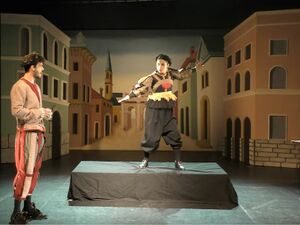Dialogues on staging tool
The Quatro Dialoghi in materia di rapresentazioni sceniche (Four Dialogues on Staging) were written by Leone de' Sommi in 1568. They cover the use of voice and body, the set, the lighting and the costumes.
The Dialogues on Staging teaching tool is a video of a staged performance of the dialogues, discussing the importance of the technicians and the technics to the theatre event. The video can give an expanded understanding of the text, and therefore a better understanding of the staging practices of the 16th century.
The video is available directly on YouTube.
Rosa Fernández Cruz directed a performance of the Dialogues at RESAD, and offers the following notes:
The dramaturgical and staging proposal was based on the search for a simple and understandable language for the audience. To this end, the contemporary reading aimed to approach comedy. An actor and an actress play different characters, with an interpretation that is somewhere between gestural and textual. In each scene, one of the characters operated as the white-faced clown, and the other as Augusto. The rehearsals were based on the creation of a score of actions for each scene, and a very clear importance of the elements and themes to be dealt with. A third character, the light, appeared in one of the scenes as a reference to the scenographic context we were talking about.
You can stage the dialogues yourself, following our teaching methodology From Text to Theatre: staging the dialogues of Leone de’ Sommi.
Learn more about how the set was designed and built, or make your own:
- Workshop to build a scenography for de’ Sommi’s dialogues
- Investigating Accelerated Perspective Using Serlio’s Scenes.
Credits
Staging: Rosa Fernández Cruz
Performers: RESAD 4th year students in text based theatre: Alba López Fernández and Javier Martín Hernández
Set design: Carmen Arias, Felisa de Blas and Almudena López Villalba with RESAD 2nd year set design students
Lighting design: Miguel A. Camacho and RESAD 2nd year set design students
Costume design: RESAD 3rd year set design students Beatriz López Ruiz and Amalia Izagirre.
